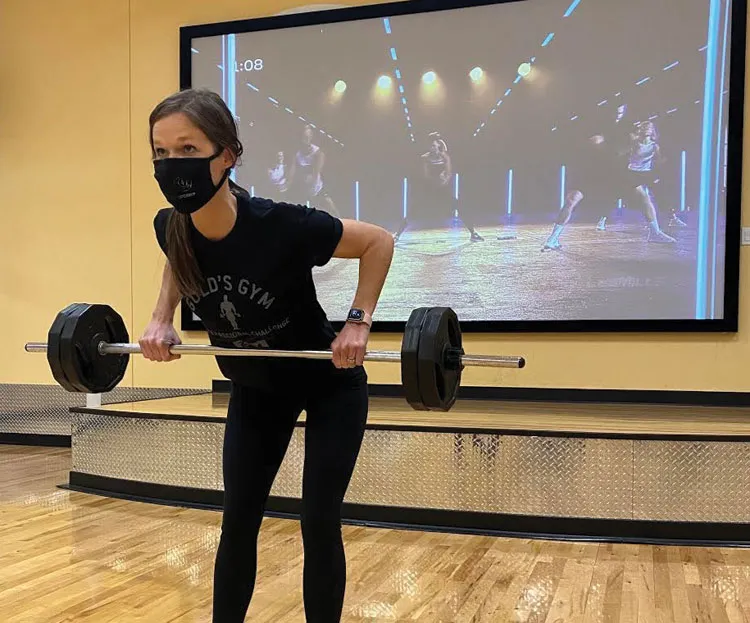Gyms surviving ultimate endurance exercise

The COVID-19 pandemic has been a heavy lift for fitness centers in the Boulder Valley and Northern Colorado, but a return to economic health seems finally in sight.
“As of December, we had lost about half of our membership base. That’s when it really got tough when we got to about 10% of capacity when the spike [in the disease] happened,” said Allison Hockstad, general manager of Gold’s Gym in Longmont. “January was still a loss, but February is our first month projection in a year to gain more members than we’ve lost. We finally felt like we hit that plateau last month and that this will be the first month that we’re starting to climb back.”
Falling rates of coronavirus cases earned Broomfield County an upgrade to Level Blue on the state’s dial of pandemic-related restrictions in late February. For gyms, that means expansion from 25% of capacity to 50% or 175 people in a room. Also in February, businesses in Larimer County that are approved to operate under the county’s Level Up program, which permits businesses to operate with greater flexibility in terms of COVID-19 restrictions, were allowed to move to Level Yellow, which meant gyms could have up to 50 people per room.
SPONSORED CONTENT
Gyms had survived a state-ordered shutdown March 17 that lasted about three months. Some initially set up a virtual platform but then decided to close altogether. Most gyms reopened in mid-June but were limited to 25% capacity, six-foot distancing and mandatory masks.
The financial hit forced several individual studios and chains such as Gold’s and 24-Hour Fitness to seek Chapter 11 bankruptcy protection. The latter company permanently closed 13 Colorado gyms, including locations at 4650 W. 120th Ave. in Broomfield, 460 S. College Ave. in Fort Collins and 3001 S. 23rd Ave. in Greeley. But when restrictions were lifted partially, it opened 18 locations including at 2900 Iris Ave. in Boulder, 2208 E. Harmony Road in Fort Collins and 851 N. U.S. Highway 287 in Lafayette.
Having the finish line finally in sight is a relief after a year-long marathon of diminished returns that, at some locations, included pushback from some regular members — especially in places such as Longmont, which straddles two counties with markedly different cultural and political slants.
“We’re in an interesting area, being in Boulder County, but we have a lot of members from Weld County,” Hockstad said. “It makes it a very interesting place to work. We definitely have some members who really do not want to wear the mask, don’t enjoy wearing the mask, and then some who are very passionate about everyone wearing the mask at all times. We have some gyms in different counties where it’s less split, but people are definitely in disagreement here.
“I have definitely been yelled at,” said Hockstad, who started at Gold’s Longmont location when it opened five years ago in part of a former Dillard’s department-store building in what is now Village at the Peaks. “It’s more the regulations. They’re more upset with the county or the state than with me, but I’ve never had this much pushback on anything.
“Now that it’s been around for so long, most people are on board with it, but that was definitely a struggle. It’s tough to work out in a mask, I will say that.”
The distancing requirement was made easier by a business model that included extended hours, said Jeremy Levinson, general manager of an Anytime Fitness location about two miles north of Gold’s.
“We’d make a time slot for people to come in,” he said. “We’re open 24 hours, so people could come in any time. The 25% capacity would mean 15 people per hour, but we didn’t even typically have more than five people per hour.
“You don’t have to make a reservation anymore.”
All gyms stepped up their sanitation regimes, with staffers and customers alike wiping down machines after use.
At Gold’s, “we’re requiring members to sanitize equipment, and people are pretty good about cleaning,” Hockstad said. At Anytime Fitness, Levinson said, “they wipe it down after and then we wipe it down. Then we have a cleaning crew in the morning and at night.”
Gold’s “changed little things,” Hockstad said. “We no longer offer sweat towels or a coffee station — shared things like that. We mark off every other piece of cardio equipment, and we’re offering fewer classes than we used to have. Everything is running; it’s just at a lower capacity.”
One of that club’s features is a movie room, where members can work out on stationary bikes, treadmills and other pieces of equipment while watching a recent film. That’s been a plus for customer comfort, Hockstad said.
“If people are in a separate room with four walls and a door, they can pull their mask down as long as they’re in there alone,” she said. “They can’t be with anyone not in their household, but still that’s helped for people who wanted to do harder cardio.”
Whereas bigger gyms generally were able to survive even the late-2020 spike in COVID-19 cases and Colorado’s resulting restriction to 10% capacity, the going was much tougher for small boutique studios that already were struggling at 25% capacity. For some of those, 25% meant nine to 10 people at a time in the studio, and a reduction to 10% meant only three or four people allowed in at a time. For some small fitness and yoga studios, 10% meant spending more on payroll than they were generating in revenue.
That kind of pinch led several gym operators in August to form the Colorado Fitness Coalition to lobby government officials. Noting that the state’s fitness industry generates $695 million in revenue in a typical year, the coalition warned officials that Colorado could lose an estimated 200 gyms, 22,000 jobs and $12 million in payroll taxes if restrictions weren’t eased. It also pointed to a University of Oregon study of Colorado health clubs released in December that used 32 weeks’ worth of Colorado Department of Public Health and Environment data, encompassing nearly 8.5 million check-ins, and found no link to the 59 outbreaks reported by CDPHE. The coalition contended that the results showed that gym attendance was safer than visiting bars, restaurants or grocery stores.
However, a study released in January by the University of Colorado Boulder noted that the body of an exercising person emits as many chemicals as those of up to five sedentary people. It said those emissions from breath and perspiration, when combined with the chemicals used for sanitation, form new airborne chemicals with unknown impacts to indoor air quality.
As a whole, the fitness industry has made changes — some experimental, others long-term — that could forever change how gyms are designed and run. Changes in ventilations systems already are being credited with keeping clubs’ infection rate low, and many centers are developing secure outdoor exercise spaces as well as virtual classes and trainer-led exercises.
Fitness consumers have developed different habits as well that may persist long after gyms have returned to normal — or whatever the post-pandemic normal looks like.
“As soon as the lockdowns took effect, the home-fitness business — everything from yoga mats to high-tech cardio machines — took off like wildfire,” said Matt Powell, vice president and senior industry adviser for market research company NPD Group. He said revenue from those retail sales more than doubled, to $2.3 billion nationwide, from March to October, with sales of treadmills up 135% and stationary bikes nearly tripling.
They’re hitting the outdoors as well. Managers of tracts ranging from city and county parks to Rocky Mountain National Park have noted sizable spikes in use, especially by trail runners.
Still, spring 2021 is bringing sprouts of optimism at most fitness centers.
“As a facility we have had no outbreaks,” Hockstad said. “We feel that the gym is a safe place to be with the precautions we have, the masks and the lower capacity.
“Just this week we had multiple older people come back saying they’ve gotten both of their vaccinations. They’re just starting to flock back. That’s what’s going to be the key — for people to feel more comfortable coming back to the gym.
“It’s been super hard,” Hockstad said, “but I’m feeling optimistic for the first time in a long time this month that things are going to get better.”
The COVID-19 pandemic has been a heavy lift for fitness centers in the Boulder Valley and Northern Colorado, but a return to economic health seems finally in sight.
“As of December, we had lost about half of our membership base. That’s when it really got tough when we got to about 10% of capacity when the spike [in the disease] happened,” said Allison Hockstad, general manager of Gold’s Gym in Longmont. “January was still a loss, but February is our first month projection in a year to gain more members than we’ve lost. We finally felt like we hit that plateau…


